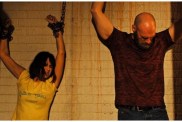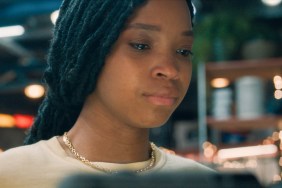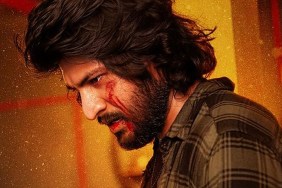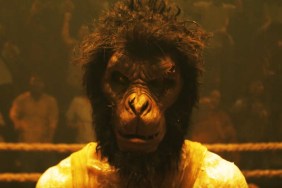Arriving at Vancouver Film Studios, also the home of SCI FI’s “Battlestar Galactica,” we were directed through the back of two large sound stages. Perhaps because the week’s shooting schedule was happening outdoors at night, or perhaps because they knew the “internet guys” were coming, the stages were virtually empty other than greenscreen, some makeup stations and some sleek looking vehicle props.
We were on our way to visit Concept Illustrator Tim Flattery, whose credits include Mission: Impossible III, Pirates of the Caribbean: Dead Man’s Chest and the design of the Batmobile in Batman Forever. Behind a large, black curtain, Flattery proudly waited beside his latest creation, the full-sized Fantasticar.
As anticipated by FF fanatics as each Batmobile is to Bat-fans, an image of the sleek craft debuted in USA Today the week after we visited. During Toy Fair this February, fans saw even more images of the Fantasticar in toy form from Hasbro. Our first look was accented with many “oooh”s and “ahhh”s and “oh, cool”s.
That afternoon, Director Tim Story would describe the car as “the coolest thing in the world!”
“We tried to get the Fantasticar in the last movie,” Story said, “but it didn’t make sense for it to come that early.” When the sequel started to take shape, “the two top things I started working on were the wedding and the Fantasticar. The car is like the fifth character of the Fantastic Four and it’s just cool, you know. Flying cars and breaking up in pieces, and them all having their own pod and having control. I just knew it would be as cool to the audience as it seems to me, so I just got into it immediately.”
“Maybe it’s because I helped design the Batmobile,” Flattery said, “but people seem to see the Batmobile in everything. Maybe because it’s such an icon. That was part of the challenge with this, it had to be something so unique and original. And so, Tim [Story] and I discussed what it should be and what it could do and I went away and did a bunch of different sketches. His reactions to them were that it had to be really aggressive and cool, but yet soft. And so, I started drawing from nature, the shape is basically derived from a stingray.”
“I’m a comics nut,” Flattery explained, “so I always try to pay homage to what’s been there and what I grew up with. But in this case, what’s been done in the comics just didn’t apply to the movie. So, I tried to keep it in the back of my head, but really the homage to the comic is that it breaks apart.”
Where the comic incarnations generally split into four pieces, the movie version breaks apart in two places to make three modules. “We keep Sue and Reed together,” explained Flattery.
Fox notes that in the film, the Fantasticar is a 20-foot long, 12-foot wide hybrid vertical take-off / landing craft combining electric-powered fan lift and jet turbine thrust that yields maximum fuel efficiency. Constructed from high-tech composites, it has a maximum speed of 550 miles per hour (with the entire quartet on board) and a maximum altitude of 30,000 feet. Each of the three break-away sections deploys with articulated wings, is independently controlled, and is self-powered to maintain the same speed and performance of the unified craft.
“When I did the Batmobile,” explained Flattery, “we sculpted the whole thing full size out of clay, and then molded it from there. But now, we’ll take my design and build it digitally in a program from Alias, and from that we’ll build all the molding and the tools direct from the model. There’s no sculpting involved any more. It’s a great process. Saves a whole lot of time.”

The actors’ first exposure to the design was the full-sized model. “They walked up to it and everybody was pretty fired up,” recalled Flattery. “They had a lot of questions. Even Tim Story, who obviously did know, when he finally arrived up here — he took his shoes off, got up on top of the thing and was running up and down. He got in every single cockpit and was making ‘brrrrt’ noises. It was pretty funny, jumping from one to another and pushing every button for about half an hour.”
Taking four months to build with an estimated cost of over a million dollars, the just-under 1000 pound prop is build for hero-shaking action.
“It’s up on a gimbal all the time,” Flattery explained. “The cradle that it’s sitting on now, where you see the points that it’s resting on the cradle, that’s where the gimbal picks it up. You have to pay attention to the frame structure which the engineers design first. You can walk all over this. You don’t worry about body panels cracking on you, twisting in the torque. They’re bulletproof.”
A pilot himself, Flattery relied on his knowledge of aviation to go into the ship’s instruments. “For the main functions, I think about them heavily while I’m designing. How does it work? How does the thrust work? How does it lift? What kind of controls to you need inside to control the lift? What controls do you need inside to control the thrust? There are some things you have to think about ahead of time, because you have to be script conscious.”
For the instrument control panels, however, Flattery doesn’t think it through too much. “Where you see these screens, I don’t put anything static there, because it will be added by video later… whatever they want to put in to accommodate.”
Getting Thing in and out of the back seat was something that concerned Flattery from the beginning. “The only way to get into this vehicle is to drop in it. You have to walk up on the belt line, then stick your foot down on the seat, then slide in. This is so low profile. So how is a guy in 70 pounds of rubber going to get in? I don’t know if you’ve seen that suit, but it’s huge… there’s a lot of mass on it. The best scenario is just walk up the back with his own ramp. It’s not easy to get in to. But, it’s like getting into a sports car.”
Likely to stir some controversy among fans is the involvement of Dodge branding on the vehicle, and even incorporation into the storyline. “There’s reference to Dodge’s involvement in the design of the car,” Flattery said. “There’s definitely references to it in the script.”
“When I did the Batmobile, there wasn’t any car company involved. But now it’s more and more relationships with more and more different types of companies, not just car companies. Computer companies, and fast food and all that kind of stuff. Usually, it’s been my experience on movies that there will be a few car companies wanting to be involved. In this case it was Dodge, and I tried to accommodate that.”
Flattery assured us that corporate sponsorship had little impact on the final design. “[Dodge] came in sort of late in the process. We sent renderings to them because of their involvement, they wanted to see it. The biggest request was the Ram’s head logo and seeing if we could work in the crosshair on the front end, in my own way. The front end always looked like this anyway, it was originally designed like a fish mouth and so it was natural.”









